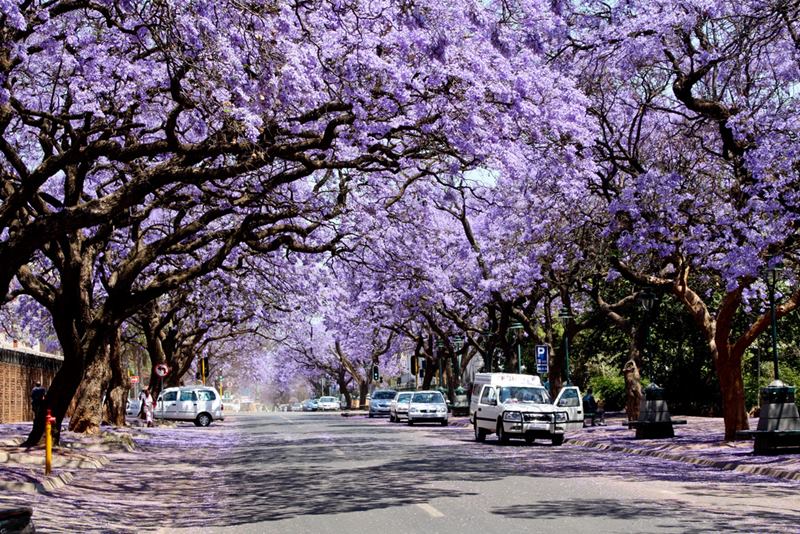The Jacaranda Tree: A South African Icon?
Is the jacaranda tree truly native to South Africa? The vibrant purple blooms that blanket streets and parks each spring have become synonymous with the South African landscape, particularly in cities like Pretoria and Johannesburg. This stunning visual spectacle often leads people to believe these trees are indigenous, a natural part of the South African flora. However, the truth is a bit more complex and quite fascinating.
The jacaranda tree's origins trace back to South America, specifically regions like Brazil, Bolivia, and Argentina. This begs the question: How did these South American natives become so deeply ingrained in the South African identity? The story begins in the 19th century, a time of horticultural exploration and exchange.
The introduction of jacaranda trees to South Africa is a story of globalization and adaptation. Around the 1880s, jacaranda trees were imported and planted in various parts of the country. Pretoria, known as the "Jacaranda City," embraced these newcomers with particular enthusiasm. The trees thrived in the South African climate, quickly establishing themselves as a beloved feature of the urban landscape.
The jacaranda's beautiful blossoms have undoubtedly captured the hearts of South Africans. They've become a cultural symbol, associated with the arrival of spring and student exam season. The purple haze that descends upon cities is celebrated, photographed, and even inspires local folklore. However, the widespread presence of these non-native trees has raised ecological concerns.
While the jacaranda tree enhances the aesthetic appeal of South African cities, its impact on the local ecosystem is a subject of ongoing debate. Some argue that the jacaranda, being a fast-growing and water-intensive species, could outcompete indigenous vegetation and disrupt the natural balance of the environment. This concern highlights the complex relationship between beauty, cultural adoption, and ecological responsibility.
The Jacaranda mimosifolia is the most common species found in South Africa. It's known for its vibrant purple flowers, feathery leaves, and fast growth rate. The trees can reach impressive heights, creating a canopy that provides shade during the hot summer months.
One of the benefits of Jacaranda trees is their aesthetic appeal. They transform cities into stunning landscapes, attracting tourists and boosting local pride. The trees also provide shade, reducing urban heat island effects. Finally, while not a primary timber source, their wood can be used for crafting furniture and musical instruments.
Advantages and Disadvantages of Jacaranda Trees in South Africa
| Advantages | Disadvantages |
|---|---|
| Aesthetic beauty | Potential invasiveness |
| Shade and urban heat island reduction | Competition with native flora |
| Timber for crafting | High water consumption |
Best Practice for managing Jacaranda Trees: Implement controlled planting strategies to avoid overpopulation, prioritize native species in sensitive ecosystems, and explore methods for water-wise irrigation. Monitor the spread of Jacaranda trees and their impact on local biodiversity. Conduct public awareness campaigns to educate communities about the ecological implications of non-native species.
Frequently Asked Questions:
1. Are Jacaranda trees native to South Africa? No, they are native to South America.
2. When do Jacaranda trees bloom? Typically in spring, around October and November.
3. Why is Pretoria called the Jacaranda City? Due to the abundance of Jacaranda trees planted there.
4. Are Jacaranda trees invasive? They have the potential to be invasive in certain ecosystems.
5. What are the ecological concerns regarding Jacaranda trees? Competition with native flora and high water consumption.
6. Can Jacaranda wood be used for anything? Yes, it can be used for crafting furniture and musical instruments.
7. Where can I see Jacaranda trees in South Africa? Pretoria and Johannesburg are particularly known for their Jacaranda displays.
8. How can I help manage the spread of Jacaranda trees? Support local initiatives that prioritize native vegetation and responsible tree planting.
Tips for appreciating Jacarandas: Take photos during peak bloom, attend local Jacaranda festivals, and learn about the tree's history and impact. Be mindful of the ecological debate surrounding the species and support efforts to protect indigenous biodiversity.
The jacaranda tree, despite its non-native status, has become a cherished part of the South African landscape. Its vibrant blossoms have created an iconic visual experience, woven into the cultural fabric of the nation. However, it's crucial to acknowledge the ecological complexities surrounding this beloved tree. Balancing the aesthetic and cultural benefits with the need to preserve indigenous biodiversity is essential for a sustainable future. By understanding the origins, impact, and ongoing debate surrounding the jacaranda tree, we can appreciate its beauty while actively promoting responsible environmental stewardship. This involves supporting local initiatives that prioritize native flora, promoting sustainable planting strategies, and fostering a greater awareness of the delicate balance within our ecosystems. Let's embrace the beauty of the jacaranda while working towards a future where both native and adopted species can coexist harmoniously.
Tai crafting building a deep dive into this emerging trend
Unlocking your dreams using your epf to buy a home in malaysia
The enchanting allure unveiling morgan le fay in the dc universe











.jpg)


